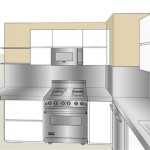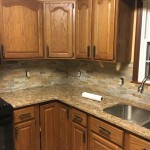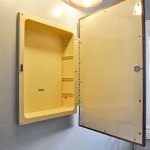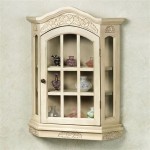Organizing Your Kitchen With Free-Standing Sink Cabinets
Kitchen organization is paramount for efficient meal preparation and a pleasant cooking environment. The sink area, often a high-traffic zone, especially benefits from well-planned organization. Free-standing sink cabinets offer a versatile and adaptable solution for maximizing space and streamlining functionality in this critical area. Understanding the benefits, selecting the right cabinet, and implementing effective organizational strategies are crucial for transforming a cluttered sink area into a model of efficiency.
Free-standing sink cabinets, as opposed to built-in units, offer a tangible advantage in terms of flexibility. They are not permanently attached to the kitchen structure, affording homeowners the freedom to reposition them during renovations or to accommodate changing spatial needs. This adaptability is particularly valuable for renters or individuals who anticipate future modifications to their kitchen layout. Furthermore, free-standing cabinets are often easier and less expensive to install than custom-built units, making them an attractive option for budget-conscious homeowners.
Beyond their flexibility, free-standing sink cabinets come in a diverse range of styles, sizes, and materials. This variety allows homeowners to select a cabinet that perfectly complements their existing kitchen décor and meets their specific storage requirements. From rustic farmhouse designs to sleek modern aesthetics, the options are virtually limitless. Material choices range from traditional wood to durable laminate and stainless steel, each offering distinct advantages in terms of aesthetics, maintenance, and longevity.
Effective organization within and around the free-standing sink cabinet is essential for maximizing its utility. This involves strategic placement of items, the utilization of organizational accessories, and the implementation of habits that promote cleanliness and order. A well-organized sink area reduces clutter, minimizes wasted time searching for items, and enhances the overall efficiency of kitchen tasks.
Key Point 1: Selecting the Right Free-Standing Sink Cabinet
The selection process for a free-standing sink cabinet should be guided by a careful assessment of individual needs and preferences. Several factors warrant careful consideration, including size, style, material, and storage capacity. Neglecting these aspects can result in a cabinet that is either functionally inadequate or aesthetically jarring.
Size is a critical consideration. The cabinet must be appropriately sized for the available space in the kitchen and should accommodate the existing sink dimensions. Measuring the sink and the designated area before making a purchase is crucial. A cabinet that is too large will impede movement and disrupt the workflow, while one that is too small will fail to provide adequate storage. Height is also a relevant factor, ensuring comfortable working conditions and preventing unnecessary strain.
Style is another important aspect. The cabinet should complement the overall aesthetic of the kitchen. Consider the existing cabinetry, flooring, and appliances when selecting a style. A cohesive design creates a more visually appealing and harmonious environment. Options range from traditional styles with raised panels and ornate hardware to contemporary designs with clean lines and minimalist details. The choice should reflect personal preferences and the desired ambiance of the kitchen.
Material selection impacts both the appearance and durability of the cabinet. Wood cabinets offer a classic and timeless look, but they require regular maintenance to prevent moisture damage. Laminate cabinets are more affordable and resistant to water damage, making them a practical choice for busy kitchens. Stainless steel cabinets are exceptionally durable and easy to clean, offering a modern and industrial aesthetic. Consider the expected use and the level of maintenance required when selecting the material.
Storage capacity is a key consideration for maximizing the functionality of the sink cabinet. Evaluate the items that will be stored within the cabinet, such as cleaning supplies, dish soap, sponges, and trash bags. Choose a cabinet with sufficient shelves, drawers, and compartments to accommodate these items in an organized manner. Adjustable shelves offer added flexibility for storing items of varying sizes. Consider the presence of features such as pull-out trays or wastebasket compartments to further enhance organization.
Key Point 2: Organizing the Cabinet Interior
The interior organization of the free-standing sink cabinet is crucial for maximizing space and accessibility. Implementing effective organizational strategies transforms a chaotic storage space into a model of efficiency. This involves utilizing appropriate storage solutions, decluttering regularly, and establishing designated areas for various items.
Utilizing organizational accessories is essential for maximizing space within the cabinet. Shelf dividers can create separate compartments for different types of items, preventing them from becoming jumbled together. Under-sink organizers with sliding drawers or tiered shelves provide convenient access to cleaning supplies and other frequently used items. Door-mounted organizers are ideal for storing sponges, scrub brushes, and dishcloths. These accessories maximize vertical space and keep items within easy reach.
Regular decluttering is necessary to prevent the buildup of unnecessary items. Expired cleaning supplies, empty bottles, and rarely used items should be discarded regularly. A thorough decluttering session should be conducted at least twice a year. This helps to maintain a manageable inventory and prevents the cabinet from becoming overcrowded. Before restocking, consider whether each item is truly necessary and whether it can be stored elsewhere in the kitchen.
Establishing designated areas for different types of items promotes order and efficiency. Cleaning supplies should be grouped together in one area, while dishwashing detergents and sponges should be stored in another. Trash bags can be stored in a designated compartment or on a roll dispenser. Labeling shelves and drawers can further enhance organization and make it easier to locate items quickly. Maintaining a consistent system of organization simplifies the task of finding and retrieving items.
Consider the placement of items based on frequency of use. Frequently used items, such as dish soap and sponges, should be stored in easily accessible locations. Less frequently used items, such as extra cleaning supplies, can be stored on higher shelves or in less accessible areas. This arrangement optimizes the workflow and minimizes wasted time searching for items.
Key Point 3: Maintaining Cleanliness Around the Sink Cabinet
Maintaining cleanliness around the free-standing sink cabinet is essential for preventing mold, mildew, and unpleasant odors. Regular cleaning and maintenance also extend the lifespan of the cabinet and contribute to a healthier kitchen environment. Implementing simple cleaning habits and addressing spills promptly prevents the buildup of grime and bacteria.
Regular wiping of surfaces is crucial for preventing the accumulation of dirt and grime. The sink area is prone to splashes and spills, which can quickly lead to the buildup of residue. Wiping down the countertop, sink basin, and cabinet doors daily with a damp cloth or sponge helps to keep the area clean and sanitary. Using a mild detergent or disinfectant on a regular basis further inhibits the growth of bacteria.
Addressing spills promptly is essential for preventing stains and water damage. Liquid spills should be cleaned up immediately with a absorbent cloth. Allowing spills to linger can lead to permanent staining and damage to the cabinet material. For difficult stains, use a specialized cleaning product designed for the specific type of material. Avoid using abrasive cleaners, which can scratch or damage the surface.
Preventing moisture buildup is crucial for preventing mold and mildew growth. Moisture can accumulate around the sink area due to splashing, dripping faucets, and condensation. Regularly check for leaks and drips and repair them promptly. Ensure adequate ventilation in the kitchen to reduce humidity levels. Consider using a dehumidifier in areas that are prone to moisture buildup.
Cleaning the interior of the cabinet regularly is also important. Remove all items from the cabinet and wipe down the shelves and walls with a damp cloth or sponge. Use a mild detergent or disinfectant to remove any stains or spills. Allow the cabinet to air dry completely before replacing the items. This helps to prevent the buildup of mold, mildew, and unpleasant odors.
Consider using shelf liners to protect the cabinet surface from spills and stains. Shelf liners are available in a variety of materials, including plastic, rubber, and fabric. They provide a barrier between the cabinet surface and the items stored within, making it easier to clean up spills and preventing damage to the cabinet material. Replace shelf liners regularly to maintain a clean and sanitary environment.

The 15 Best S For Organizing Above Your Kitchen Sink

How To Organize Kitchen Cabinets In 9 Simple Steps Trusted Since 1922

How To Organize Your Kitchen For Efficiency

Galley Kitchen Remodel Organization Reveal Organized Ish

How To Organize Your Kitchen Cabinets One At A Time

18 Genius Under The Sink Storage Ideas And Organizers

12 Best Under Sink Organizers 2024

How To Organize Your Kitchen Cabinets Wirecutter

Organize Your Bathroom Sink Area Like A Professional Container Stories

The Perfect Under Sink Organization Solution Thrifty Decor Diy And Organizing
Related Posts








